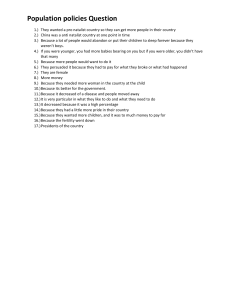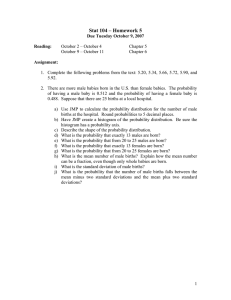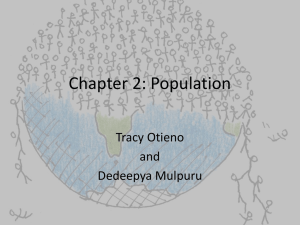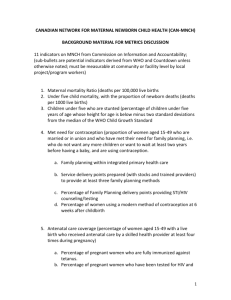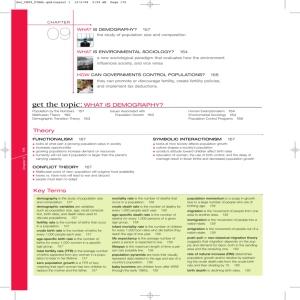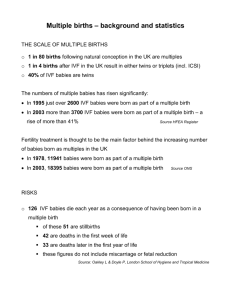Definition of ANTI NATALIST:
advertisement
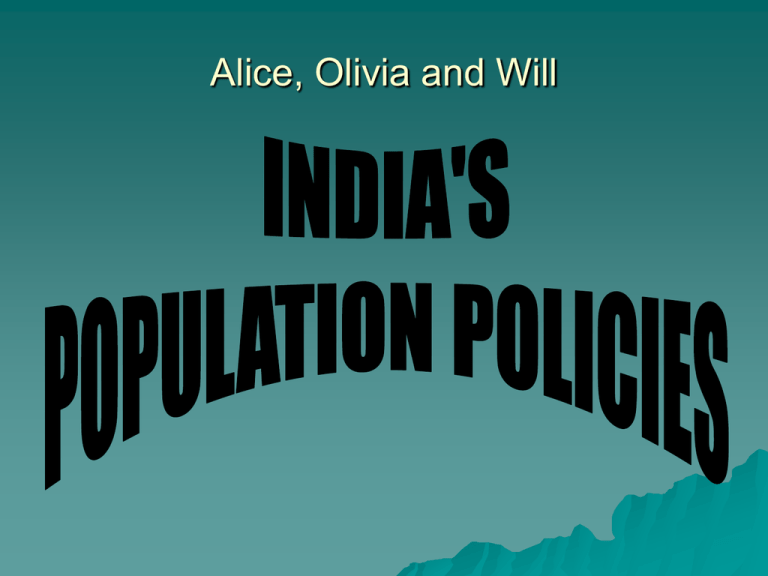
Alice, Olivia and Will Definition of ANTI NATALIST: The policy of the government to slow the population growth by attempting to limit the number of births INDIA Background information India has had a sudden fall in death rate due to improvements in food supply, hygiene and medical care High birth rate means there has been a dramatic increase in population Contraceptives and family planning were available to families In 1972, abortions were allowed by law and sterilization programmes became widespread INDIA’S POPULATION STATISTICS The population in India at 0:00 hours in the 1st of March stood at 1,027,015,247 persons, crossing the one billion mark Between 1991 and 2001, the population grew by 21.34 % Males = 531, 277, 078 Females = 495, 738, 169 Although India only occupies 2.4% of the world’s land area, it supports 15% of the world’s population Almost 40% of Indians are younger than 15 The magnitude of the annual increase in population can be seen in the fact that India adds almost the total population of Australia every year Between 1947 and 1991, India’s population more than doubled In 1901, India counted 77 persons per sq km In 1981, there was 216 persons per sq km INDIA’S FACTS At the beginning on the century, endemic disease, periodic epidemics and families kept the death rate high…enough to balance out the high birth rate Between 1911 and 1920, the birth and death rates were virtually equal; about 48 births and 48 deaths per 1000 By the mid 1990s, the estimated birth rate had fallen to 28 per 1000 The estimated death rate had fallen to 10 per 1000 The future configuration of India’s population depends on what happens to the birth rate Even the most optimistic projections do not suggest that the birth rate could drop below 20 per 1000 POPULATION INCREASE In 1981, the population census showed that there were 12 million more people than the government thought India is a democracy so laws could not be introduced to limit the number of babies born There is a nation wide campaign persuading people to have less babies Contraception, such as the pill and the coil are being used to limit birth rates THE POLICY The anti natalist policy was unpopular and ended in 1977 In 1978, the legal age of marriage was raised from 15 to 18 but this was ignored Only 25% of women use contraception In 1952, India was the first country in the world to launch the national programme, emphasising family planning to the extent necessary to reduce birth rate to stable India launched its policy through mass media e.g. radio and TV ads EFFECTS OF THE POLICY To solve the population problems, the Indian government must quickly administer population regulations so that couples have on average two children The governments persuasive campaign for two child families and India’s obsession with having sons has lad to an increase in woman abortion female foetuses so make sure they have a boy, if not two INDIA V CHINA POPULATION PROJECTIONS FOR INDIA (millions) March 1991 846.3 March 2001 1012.4 March 2011 1178.9 March 2016 1263.5 India’s demographic achievement due to the policy • Reduced crude birth rate form 40.8 in 1951, to 26.4 in 1998 • Quadrupled the couple protection rate • Reduced crude death rate • Achieved nearly universal awareness of the need for family planning • Halved infant mortality rate from 146 per 1000 in 1951, to 72 per 1000 live births in 1998 POPULATION DENSITY, by Will – well researched PROPAGANDA POSTERS CONCLUSION Due to the policy, birth rate has declined but there is still natural increase Infant mortality has been reduced as has death rate, therefore there is still a slight increase in the population
